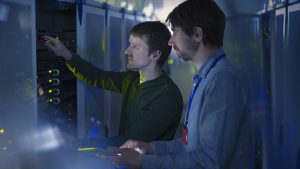At the recent DCD>Edge Summit, an overarching discussion was the true definition of edge. Most view edge as an emerging concept and classify an edge data center by its size and/or location. But what I said during a panel discussion made attendees realize that edge computing is not entirely new and might not be what they think it is.
Compute power close to a core group of users has long been implemented — from enterprise to education, retail and more. Wiring closets, for example, are a form of edge. What has changed is the importance and capabilities of these mini data centers, which have grown as technology has advanced to more a hybrid environment. Businesses are now figuring out how to better leverage the mix, but, in essence, the end goal of these environments and edge is the same.
Imagine a scenario where a large bank runs a multi-megawatt facility outside of its headquarters but not quite in the middle of nowhere. Typically, that would be considered an enterprise data center.
Then let’s say the same space is leased to a cloud provider; theoretically, it then becomes a regional wholesale colocation facility.
Now, let’s imagine the building houses multiple content providers, multiple carriers, compute network and storage. One might then call it an edge data center.
With these setups in mind, I believe that edge is not defined by size or location. It’s an application — one that depends on the technology within it and how that technology is utilized. The same thing is true for cloud. Cloud is not a location per se; it’s an application. And, as the panelists and attendees concurred, edge will mean different things to different people based on use case.
Lights out
Furthermore, I’d characterize the edge as a lights-out environment that’s connected back centrally. Edge contains converged embedded critical power, cooling, network compute and IT equipment, but in an unmanned critical facility.
Years ago, if 30KW of a data center went down, maybe a floor of people would lose email server connectivity. In today’s connected world, however, that same outage could cause cars to crash, operations to go wrong and more. Thus, edge allows for the impactful wallop of a down data center to be condensed and virtualized into a very small environment.
What is new
Think of autonomous vehicles. Automobiles are engineered to be driven by a human. Could the same engineering be utilized for self-driving cars? Perhaps the foundation will remain (4 wheels, seats, etc.), but a fundamentally different design and operating model will be necessary for success. The main functional design differences will be in the software integration to mechanical devices, ability to connect and two-way information flow.
We are in the era of AI; it’s time to have a hands-off, lights-out data center facility.
Given this context, what is new about edge — what we need to start thinking about — is how we design edge data centers. Similar to the car, why would we engineer a lights-out environment the same way we would a traditional data center? We’ve got to consider new ways of building, operating and maintaining.
I’d love to hear what you think edge is. Please comment below.
